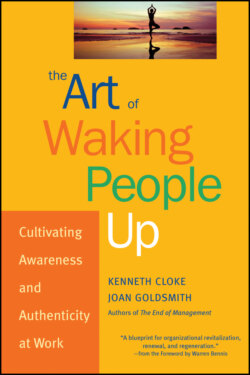Читать книгу The Art of Waking People Up - Kenneth Cloke - Страница 45
Turning Ourselves Around
ОглавлениеIn rapidly changing work environments, innumerable innovations falter or fail because prudence prompts us to settle for incremental modifications and minor improvements when wholesale transformations are demanded—not only in the things we do but in the ways we do them. To produce transformational results, we require approaches that uncover the real issues, tell the truth, speak in ways people can hear, and support people in doing what they believe is right.
There is a fundamental difference between altering, improving, or correcting something and transforming it or turning it around. Turnaround and transformation are nonlinear, unpredictable, and discontinuous. They occur through choices, leaps of committed action, deep listening, subconscious perceptions, and instantaneous flashes of insight. They take place at a right angle to accepted truth, to what is, to who we think we are.
Sometimes what is turned around is very small and escapes notice because it is so obvious or has been accepted for so long. Sometimes a personal trait is turned around that seemed unimportant at the time, or we assume it is already who we are, or we failed to notice or understand its significance. Sometimes we assume someone else is at fault, or that we are, and miss the fact that fault and blame have nothing to do with solving the problem, they simply keep us locked in patterns we do not like.
A turnaround is a crossroads, a qualitative shift in how we see or think about a problem or in the way we go about solving it. And we are always at such a crossroads at every moment in our lives. Sometimes the crossroads seems faint and distant until events bring it into focus, forcing us to act.
Because turning points are intrinsically unforeseeable, the turnaround approach to feedback, coaching, mentoring, and assessment demands an openness to the unexpected, a responsiveness to paradox and nuance, a search for hidden clues, and a willingness to be astonished. Fundamentally, it does not matter whether the shift is large or small. Small shifts can trigger enormous changes. The trick is to locate the levers, identify the catalysts, and allow learning to produce the acceleration and critical mass needed to break the grip of habit.
The role of turnaround processes and techniques is not only to provide people with the information, encouragement, and support they need to confront their problems, it is to give them the honesty they have a right to receive along with the empathy that allows them to hear it. It is to inspire them to throw away their ideational and emotional crutches and learn to walk on their own, with support from others.
